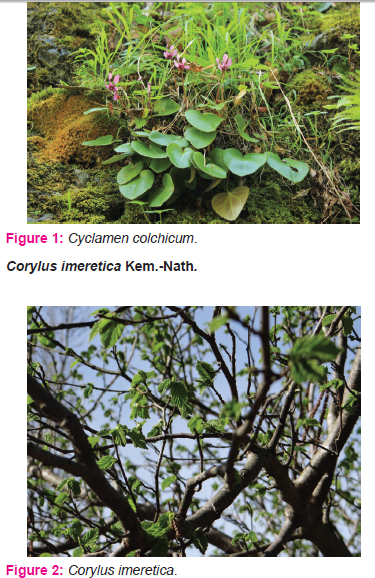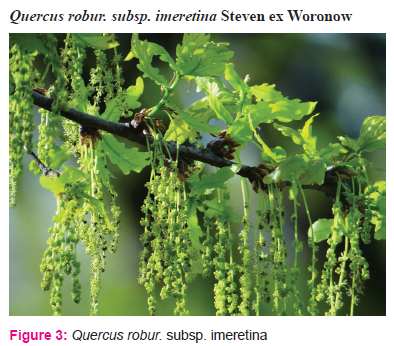IJCRR - 10(8), April, 2018
Pages: 38-41
Date of Publication: 28-Apr-2018
Print Article
Download XML Download PDF
Some Endemic Medicinal Plants Confined to Limestone Habitats of Imereti, West Georgia (the Caucasus) and Their Conservation Statuses
Author: Tamar Cheishvili, Izolda Matchutadze
Category: Life Sciences
Abstract:Aim of study: The study was aimed at collecting data on traditional use and assessing conservation statuses of some of the Caucasus endemic medicinal plants confined to limestone habitats.
Materials and Methods: The data used in the study are a part of floristic investigations conducted from 1996 to 2008 in different parts Imereti, West Georgia (the Caucasus Biodiversity Hotspot). Data on distribution, ecology, population state (rare, scarce,
common), threats collected by the author were used for IUCN Red List assessment of the four target species.
Results: Conservation statuses of the four target species used in traditional medicine were assessed as follows: Corylus imeretica Kem.-Nath., Potentilla imerethica Gagnidze and M. Sochadze (endemic to Imereti) \? VU; Cyclamen colchicum (Albov) Albov (endemic to Georgia) \? VU; Quercus imeretina Stev. ex Woronow (endemic to the Caucasus) \? VU.
Conclusions: The presented species need to be more thoroughly studied for their active compounds to justify the traditional usage of the species and search for possibilities of their use in modern medicine. Since natural resources of these species are limited and their populations experience negative effects of various factors acting as threats, relevant conservation measures are to be elaborated to protect their populations that may occur an important source for obtaining compounds with a potential to be used in medicine.
Keywords: Endemic plants, Limestone habitats, Colchis, Caucasus Biodiversity Hotspot
DOI: 10.7324/IJCRR.2018.10808
Full Text:
Introduction
Floristic region of Imereti (42°5'0'' N, 42°30'0'' E), situated in the eastern part of Colchis botanical-geographic province is characterized by great physico-geographic and floristic diversity [16, 15, 4, 5, 6, 7, 9, 11]. In the vertical cross-section between the lowest (the village Sanavardo, at the river Tskhenistskali, 15-20 m a.s.l.) and the highest sites of Imereti (Mt. Lebeuri on the Racha range, which is a branch of the Greater Caucasus; 2862 m a.s.l.) several vegetation zones are present from humid subtropical forests to alpine meadows. This is the reason for great floristic diversity and certain level of endemism in the region [20]. Special type of endemism features calcareous orographic units of Imereti formed in the Late Jurassic [1, 12, 17]. Some of the endemic plant species of the Caucasus Biodiversity Hotspot confined to limestone habitats and particularly occurring on limestone massifs of Imereti are traditionally used as medicinal plants [1, 12, 17].
Tradition of medicinal plant cultivation in special gardens has a long history in Colchis. Existence of Medea’s garden of medicinal plants a few millennia ago (XIII-XII centuries B.C.) is a rare historical phenomenon. The garden was grown in the botanical-geographic province of Colchis encompassing entire Colchis and Lazistan in Asia Minor. Although it was thought that Colchic plants suitable for the climate of Colchis were grown in the garden, results of botanical-geographic data analysis have suggested that plants of the garden were heterogeneous by their attitude to climate as well as florogenetic history with plants of arid and humid regions of the Mediterranean area, Near East, East Asia and Asia Minor being predominant [10]. But rich local plant genetic pool of West Georgia and in particular, Imereti region has also been used for medicinal purposes since ancient times [3]. Gelati monastery (XII century), a great monument of Imereti region with its neighboring churches and the Academy was an important center of spiritual and intellectual development of Georgia. Together with other fundamental disciplines medicine was taught in the Academy. Since the XII century the Xenon, a hospital, functioned at the Monastery. Some of the endemic medicinal species are still concentrated on the area of the former hospital at Gelati Monastery (XI c.) suggesting that the plants were cultivated and used in medicine for centuries since establishment of the monastic hospital [19].
Materials and Methods
The data presented in the paper are a part of a floristic study conducted from 1996 to 2008 in different parts Imereti, West Georgia, particularly, Kutaisi vicinity, Adjameti and Sataplia protected areas in the river Rioni basin, gorge of the river Tskaltsitela, forests adjacent to Gelati Monastery, Nakerala range, a branch of the Racha range, calcareous foothills of Imereti called Okriba, gorge of the river Kvirila of the river Rioni basin, Adjara-Imereti range belonging to the Lesser Caucasus system.
The plant material was collected in all the vegetation types present on the study area from 300 m to 2997 m a.s.l. The material collected during the reported survey is stored at the Herbarium of Kutaisi State University (KUT). Materials stored at the Herbaria of Ivane Javakhishvili State University of Tbilisi (TB) and Tbilisi Botanical Garden and Institute of Botany (TBI) were also used during the study.
Data on distribution, ecology, population state (rare, scarce, common), threats collected by the author were used for IUCN Red List assessment of trees and shrubs of the Caucasus at Tree Red Listing Workshop, 22-25 Sept, 2005, Tbilisi, GTSG; the Caucasus endemic plant species for the IUCN project supported by CEPF: Coordination and Development of Plant Red List Assessments for the Caucasus Biodiversity Hotspot (2006-2009).
Nomenclature follows Czerepanov [2], Gagnidze [8].
Results
Twenty-two of the Caucasus Biodiversity Hotspot endemic plant species occurring in Imereti, eight of which are endemic to this floristic region of Georgia, are confined to calcareous habitats that have encouraged formation of the endemic flora owing to ecological isolation.
Some of the species of the limestone habitats have been used by local population as medicinal plants; among them are: Corylus imeretica Kem.-Nath., Potentilla imerethica Gagnidze and M. Sochadze (endemic to Imereti); Cyclamen colchicum (Albov) Albov (endemic to Georgia); Quercus imeretina Stev. ex Woronow (endemic to the Caucasus).
Cyclamen colchicum (Albov) Albov
Distribution. Georgia: Abkhazeti, Racha-Lechkhumi, Samegrelo, Imereti.
Habitat. On rocks from lower montane to alpine zone.
Traditional usage. Tincture is used for treatment of liver diseases, neuralgia, frontitis, arthritis.
Conservation status. Global assessment – EN / B1ab(i,ii,iv,v)+2ab(i,ii,iv,v). Extent of occurrence (EOO) estimated to be less than 5,000 km2; Area of occupancy (AOO) estimated to be less than 500 km2; existence at 4--5 locations (calcareous habitats) and inferred and projected continuing decline in EOO, AOO, the number of locations/subpopulations and mature individuals caused by trampling by cattle. Population monitoring is necessary for elaboration of relevant conservation actions.

Distribution. Georgia: Svaneti, Racha-Lechkhumi, Imereti, Guria, Kartli.
Habitat. Limestone habitats in forests and forest edges in middle montane zone.
Traditional usage. Nut shell brew is used against cough and tincture against eczema and other skin diseases; leaf decoction and pericarp infusion against vein diseases.
Conservation status. Global assessment – VU / B2ab (iii). Restricted to forest. Threatened by exploitation of its habitat. The population is in continuing decline due to selective logging. Extent of occurrence is <10,000 km2. (Assessed at Tree Red Listing Workshop, 22-25 Sept, 2005, Tbilisi, GTSG).
Potentilla imerethica Gagnidze and M. E. Sokhadze
Distribution. Georgia: Imereti.
Habitat. Limestone rocks, at 700 m asl.
Traditional usage. Root brew is used against oral and gastrointestinal inflammation, tonsillitis, eczema and other skin diseases as well as burns and freezing.
Conservation status. Global assessment – VU / D2. Listed as Vulnerable in view of existence at just a single location such that it is prone to the effects of human activities (such as infrastructure development) or stochastic events within a very short time period in an uncertain future, and is thus capable of becoming CR or even EX in a very short time period.
Quercus robur. subsp. imeretina Steven ex Woronow

Distribution. Georgia: Abkhazeti, Racha-Lechkhumi, Imereti, Guria; Russian Federation: Krasnodar Kray.
Habitat. Forms forests in lower montane zone.
Traditional usage. Similar to Q. robur L. Bark of young branches is used against gastrointrstinal inflammation, hemorrhoids, skin inflammations, coarse heals.
Conservation status. Global assessment – VU / B2ab(iii,v). In Georgia present in Ajameti State Reserve, although there is a pipeline running through it. In decline due to logging. (Assessed at Tree Red Listing Workshop, 22-25 Sept, 2005, Tbilisi, GTSG).
Conclusion
The presented species need to be more thoroughly studied for their active compounds to justify the traditional usage of the species and search for possibilities of their use in modern medicine. Since natural resources of these species are limited and their populations experience negative effects of various factors acting as threats, relevant conservation measures are to be elaborated to protect their populations that may occur an important source for obtaining compounds with a potential to be used for treatment of the diseases mentioned above.
Acknowledgements
Our thanks are to the scholars whose articles are cited and included in references of this manuscript. We are also grateful to authors / editors / publishers of all those articles, journals and books from where the literature for this article has been reviewed and discussed. We thank the Editors of IJCRR for their helpful comments and editorial support and for reviews that helped improve the paper.
We thank FFI and IUCN/SSC Global Tree Specialist Group for organizing a tree Red Listing workshop in September 2005, in Tbilisi, Georgia, where global conservation statuses of the two of the presented species were assessed.
References:
- Chkheidze, O., 2004. Gomorphology of Imereti. Tbilisi. (in Georg.)
- Cherepanov, S., 1995. Vascular Plants of Russia and Adjacent States (the former USSR). Cambridge University Press.
- Eristavi, M., Sikharulidze, Sh., Mikatadze-Pantsulaia, Ts., Khutsishvili, M., Miller, J. S., McCue, K., Consiglio, T., Stone, J., 2004. Endemic Medicinal Plants of Georgia (Caucasus). CRDF grant # GBI-2312-TB-02.
- Gagnidze, R.197, Botanical and geographic analysis of tall herbaceous vegetation of the Caucasus. Metsniereba, Tbilisi. (in Russ.)
- Gagnidze, R.,1998. Situacion phytogeographique de la Georgia. Les limites de la ,,region Meditterranenne”. La Geographie en Georgia (eds.: Richar, J. F., Berouchashvili, N.). Orstom, Paris, pp. 95-102.
- Gagnidze, R.,1999. Arealogical review of Colchic evergreen broodleaved mesophyllous dendroflora species. Recent shifts in vegetation boundaries of deciduous forests especially due to general global warning (eds.: Klötzeli, Fl., Walther, G. R.). Birkhaüser Verlag, Basel-Boston-Berlin, pp. 199-21
- Gagnidze, R., 2004. Current problems and tasks of botanical geography of the Caucasus. Notulae Systematicae ac Geographicae Instituti Botanici Thbilissiensis 44-45, 8-46. (in Russ.)
- Gagnidze, R., 2005. Vascular plants of Georgia. A nomenclatural checklist. Universaly, Tbilisi.
- Gagnidze, R., Gviniashvili, Ts., Shetekauri, Sh., Margalitadze, N. 2002. Endemic genera in the Caucasian flora. Feddes Repertorium 113 (708), 616-630.
- Gagnidze, R., Khelaia, N., Margalitadze, N., Batsatsashvili, K., Churadze, M., 2009. Botanical geographical aspects of plants cultivated in Medea’s garden of medical plants in Colchis. Georgian Medical News 4, 169, 94-97.
- Gagnidze, R., Margalitadze, N., 2004. Holocene history of the high-mountain regions of botanical-geographical provinces of Georgia (according to pollen analysis). Caucasian Geographical Review 4, 63-67.
- Gagnidze, R., Sochadze, M., 1982. Specis nova generis Potentilla ex calcaries Georgiae occidentalis. Notulae Systematicae ac Geographicae Instituti Botanici Thbilissiensis 38, 3-7.
- IUCN Categories and Criteria, Version 3.1. 2001. http://www.iucnredlist.org/info/categories_criteria2001 (15 December 2009)
- Ketskoveli, N., Kharadze, A., Gagnidze, R. (Eds.)., 1971-2005. Flora of Georgia.1-15. Metsniereba, Tbilisi. (in Georg.)
- Kharadze, A., 1966. For botanical geographic division of high-mountainous regions of the Greather Caucasus. Problemy botaniki 8, 75-89. (in Russ.)
- Kolakovsky, A.,1961. Flora and vegetation of Colchis. Publishing House of Moscow University, Moscow. (in Russ.)
- Kutateladze, A.,1961. Plante endemicae in montibus calcaries Imerethiae. Notulae Systematicae ac Geographicae Instituti Botanici Thbilissiensis 22, 36-42. (in Georg.)
- Shengelia, M., 1962. Georgia’s endemics in the flora of calcareous massifs of Imereti. Bull. of the Georgian Botanical Society 1, 21-39. (in Georg.).
- Shengelia, M.,1975. Ancient Colchian-Iberian medicine. Tbilisi. (in Georg.)
- Zazanashvili, N., Gagnidze, R., Nakhutsrishvili, G., 1996. High mountain vegetation on the new vegetation map of Georgia. Journal of Vegetation Science 6, 157-158.
|






 This work is licensed under a Creative Commons Attribution-NonCommercial 4.0 International License
This work is licensed under a Creative Commons Attribution-NonCommercial 4.0 International License